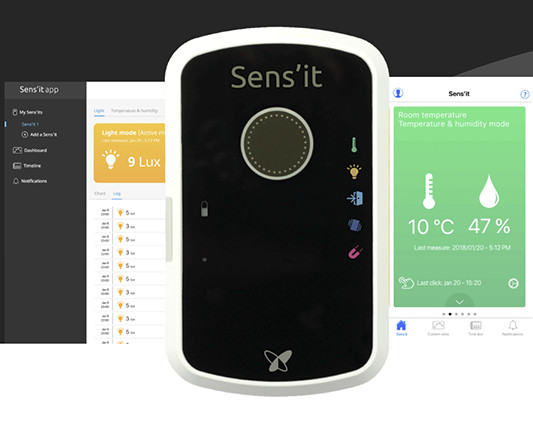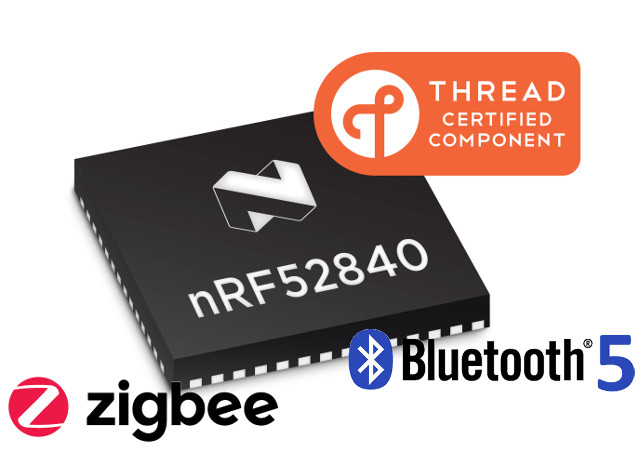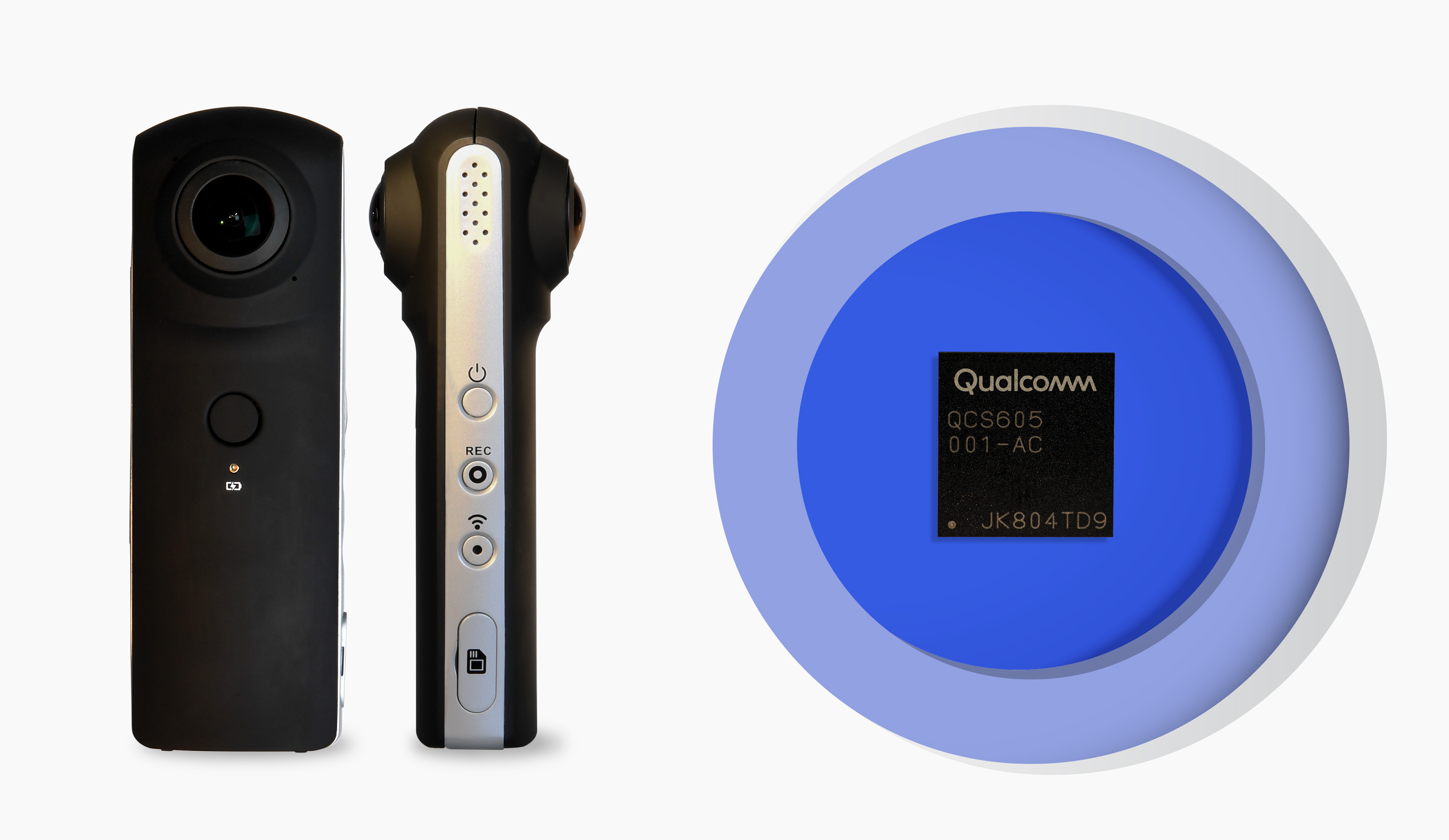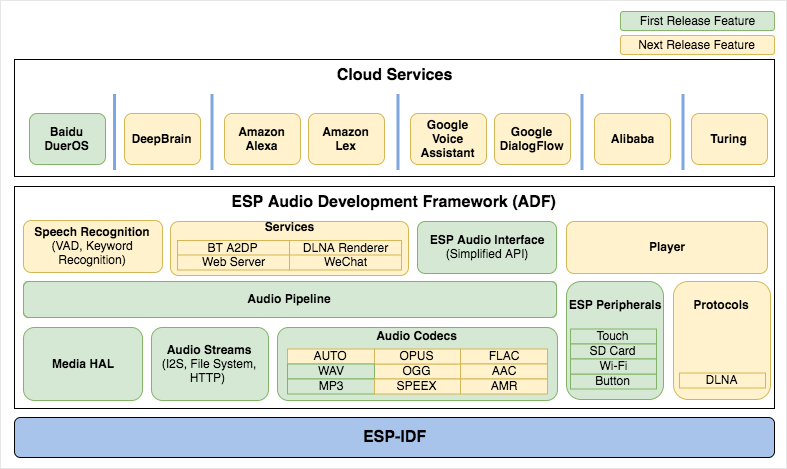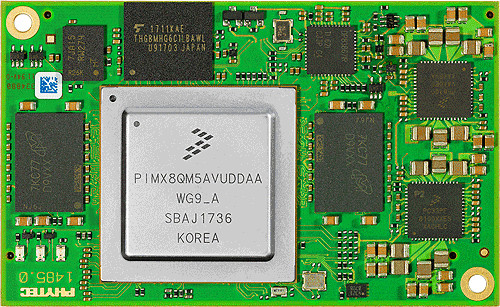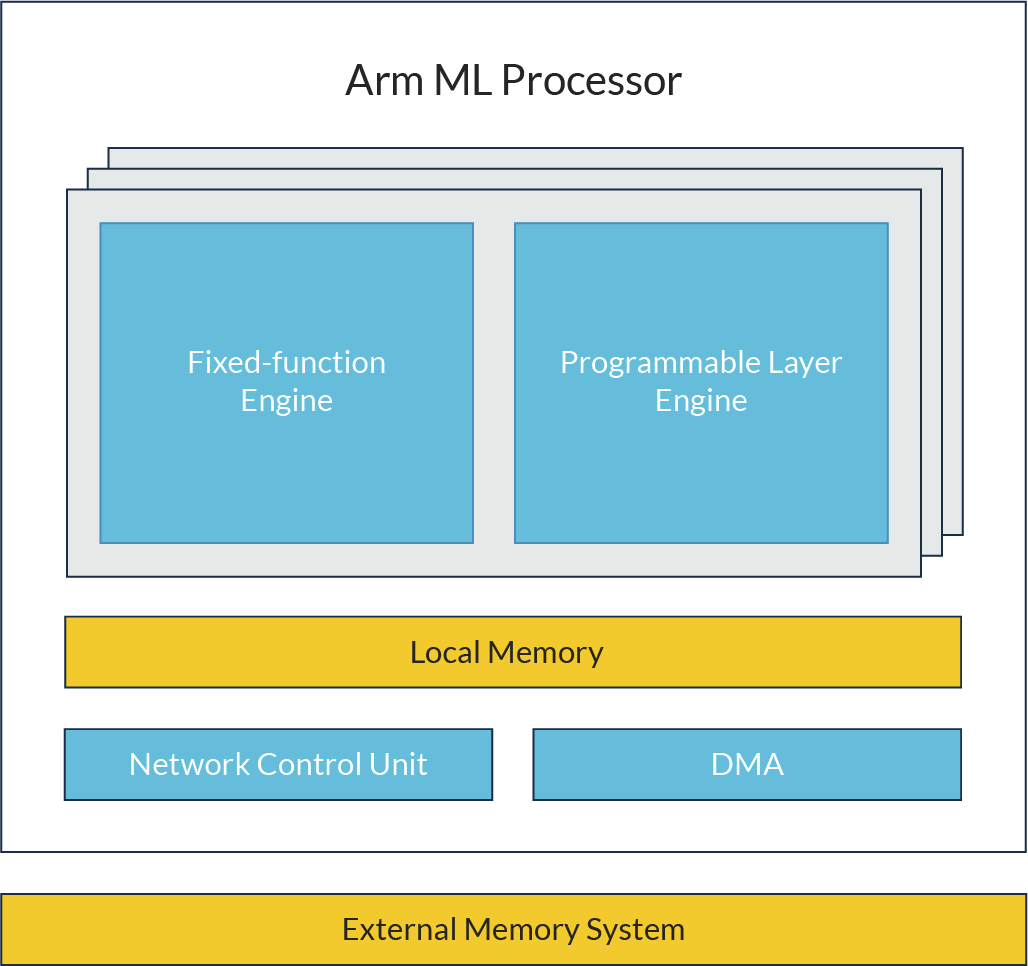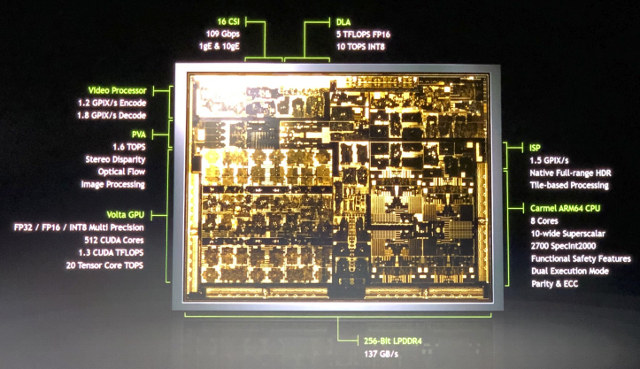Sigfox has just launched Sens’it Discovery, which they describe as a “end-to-end IoT solution, which aims to accelerate the adoption of the IoT (Internet of things) among business and technical professionals”. The solution is comprised for Sens’it 3 device with 6 sensors, sensit.io application, and Sigfox connectivity. Sens’it 3 hardware specifications: MCU – STM32 micro‑controller Connectivity TI CC1125 radio transceiver Sigfox Ready class 0U Frequencies – 868 to 869.7 MHz, 902 to 908 MHz, or 923.2 MHz (TX) / 922.2 MHz (RX), or 920 to 925 MHz depending on region Transmit Power emission – 14 dBm ERP (RC1), 22 dBm ERP (RC2), 10 dBm ERP (RC3), 22 dBm ERP (RC4) Sensors Thermometer (HTS221) – -40 to 120°C / Accuracy ± 0.5°C Humidity (HTS221) – 0 to 100 / Accuracy ± 3.5% rH (20 to +80% rH) Accelerometer (FXOS8700) – ±2, 4, 8 g / Accuracy 0.244, 0.488, 0.976 mg Magnetometer (FXOS8700) […]
Nordic Semiconductor nRF52840 Multiprotocol SoC Adds Support for Zigbee 3.0
Nordic Semiconductor nRF52840 was introduced in late 2016 as one of the first Bluetooth 5 ready SoC, and it’s the only part from Nordic that fully supports Bluetooth 5 longer range. But the chip is actually a multiprotocol SoC and beside Bluetooth, 802.15.4, Ant, Thread and 2.4 GHz proprietary are also supported. The company has now announced one more wireless protocol working on nRF52840: Zigbee 3.0. The company has released the first engineering release for Zigbee on nRF52840, but the production grade Zigbee 3.0 certified release is planed for H2 2018. The new protocol will be enabled in the S410 v6.0 SoftDevice release. Bluetooth and Zigbee can run concurrently meaning for example you could create an nRF52840 gateway to control Zigbee smart lights from a smartphone connected over Bluetooth 5. The SDK includes examples for concurrent operation of Zigbee and Bluetooth 5 for a smart light bulb and switch. The […]
Qualcomm QCS603/QCS605 “IoT” SoCs are Designed for AI and Computer Vision Applications
Qualcomm has unveiled the “Qualcomm Vision Intelligence Platform”, which aims at IoT devices with cameras leveraging artificial intelligence and computer vision. The first SoCs part of the platform are QCS605 and QCS603 manufactured with a 10nm process and equipped with an “advanced image signal processor” and the Qualcomm Artificial Intelligence (AI) Engine, as well Arm CPU cluster, Adreno GPU, and Hexagon DSP. QCS603 & QCS605 specifications: CPU QCS603 – 2x 1.6GHz Qualcomm Kryo 300 Gold cores, 2x 1.7GHz Qualcomm Kryo 300 Silver cores QCS605 – 2x 2.5GHz Qualcomm Kryo 300 Gold cores, 6x 1.7GHz Qualcomm Kryo 300 Silver cores Qualcomm Artificial Intelligence Engine DSP Qualcomm Hexagon 685 Vector Processor 2x Qualcomm Hexagon Vector eXtensions (HVX) GPU – Qualcomm Adreno 615 with OpenGL ES 3.2, Vulkan, OpenCL support Neural Processing – Qualcomm Snapdragon Neural Processing Engine programming interface with support for Tensorflow, Caffe/Caffe2, ONNE, Android NN; 2.1 TOPS @ 1w Memory […]
Espressif ESP-ADF Audio Development Framework for ESP32 Supports Baidu DuerOS, and Soon Amazon Alexa, Google Assistant, etc…
Espressif Systems have been working on audio applications like Smart Speakers based on ESP32 WiSoC with hardware development kits like ESP32-LyraTD-MSC Audio Mic HDK, and I could test it with Baidu DuerOS using Mandarin language. However, at the time (February 2018), there was not much else that could be done with the hardware kit, since no corresponding ESP32 audio software development kit had been made available. This has now changes since Espressif has just released ESP-ADF Audio Development Framework on Github. The framework will support the development of audio applications for the Espressif Systems ESP32 chip such as: Music player or recorder handling MP3, AAC, WAV, OGG, AMR, SPEEX … audio formats Play music from network (HTTP), storage (SD card), Bluetooth A2DP/HFP Integration with Media services such as DLNA, Wechat, etc.. Internet Radio Voice recognition and integration with voice services such as Alexa, DuerOS, Google Assistant As we can see […]
PHYTEC Introduces phyCORE SoMs & Devkits Based on NXP i.MX8, i.MX 8M, or i.MX 8X Processors
PHYTEC, an embedded systems company headquartered in Germany with global offices, has updated their phyCORE systems-on-module family with 3 sub-families of modules based on NXP i.MX 8, i.MX 8X, or i.MX 8M dual or quad core processors for a total of 9 modules. phyCORE-i.MX 8 Specifications: SoC – NXP i.MX 8Quad, i.MX 8QuadPlus or i.MX 8QuadMax Arm Cortex-A72/A53/M4F processor @ up to 1.6 GHz with Tensilica HiFi 4 DSP @ 666 MHz, 2x Vivante GC7000XSVX GPUs System Memory – 1 to 8GB LPDDR4 RAM Storage – 64MB to 256MB Octal SPI/DualSPI SPI NOR Flash, 4 GB to 128 GB eMMC flash, 4kB EEPROM Connectivity – 2x Gigabit Ethernet PHY 4x 120-pin Board-to-board connectors with: Display – 2x LVDS, 2x MIPI DSI, 1x HDMI Video Input / Camera – 1x HDMI, 2x MIPI CSI Audio – 2x ESAI, up to 4x SAI Networking – 2x 10/100/1000 Mbit/s Ethernet USB – 1x […]
Vulkan 1.1 and SPIR-V 1.3 Specifications Released
The Khronos Group released Vulkan 1.0 specifications in 2015 as a successor of OpenGL ES, compatible with OpenGL ES 3.1 or greater capable GPU, and taking less CPU resources thank to – for instance – better use of multi-core processors with support for multiple command buffers that can be created in parallel. A year later, we saw Vulkan efficiency in a demo, since then most vendors have implemented a Vulkan driver for their compatible hardware across multiple operating systems, including Imagination Technologies which recently released Vulkan drivers for Linux. The Khronos Group has now released Vulkan 1.1 and the associated SPIR-V 1.3 language specifications. New functionalities in Vulkan 1.1: Protected Content – Restrict access or copying from resources used for rendering and display, secure playback and display of protected multimedia content Subgroup Operations – Efficient mechanisms that enable parallel shader invocations to communicate, wide variety of parallel computation models supported […]
Arm’s Project Trillium Combines Machine Learning and Object Detection Processors with Neural Network Software
We’ve already seen Neural Processing Units (NPU) added to Arm processors such as Huawei Kirin 970 or Rockchip RK3399Pro in order to handle the tasks required by machine learning & artificial intelligence in a faster or more power efficient way. Arm has now announced their Project Trillium offering two A.I. processors, with one ML (Machine Learning) processor and one OD (Object Detection) processor, as well as open source Arm NN (Neural Network) software to leverage the ML processor, as well as Arm CPUs and GPUs. Arm ML processor key features and performance: Fixed function engine for the best performance & efficiency for current solutions Programmable layer engine for futureproofing the design Tuned for advance geometry implementations. On-board memory to reduce external memory traffic. Performance / Efficiency – 4.6 TOP/s with an efficiency of 3 TOPs/W for mobile devices and smart IP cameras Scalable design usable for lower requirements IoT (20 […]
NVIDIA Xavier AI SoC Now Sampling, DRIVE IX & DRIVE AR SDKs Announced
Well over a year ago, NVIDIA introduced Xavier, their next generation self-driving and artificial intelligence processor, with eight custom ARM cores, a 512-core Volta GPU, and support for 8K video encoding and decode. A few months ago, the company provided some more details and unveiled NVIDIA DRIVE PX Pegasus A.I. computer for level 5 autonomous driving with two Xavier processors and two NVIDIA next-generation GPUs delivering a total 320 TOPS of computing power. For that it’s worth, 320 TOPS is about 3200 times more powerful than Intel Movidus Neural Network Compute Stick. CES 2018 has now started, and NVIDIA made several announcement related to gaming and automotive markets, and confirmed Xavier is now sampling to select customers. What’s really new from the announcement is the addition of two new SDKs (software development kits) for the processor beside the original NVIDIA DRIVE AV autonomous vehicle platform: DRIVE IX – Intelligent experience […]


